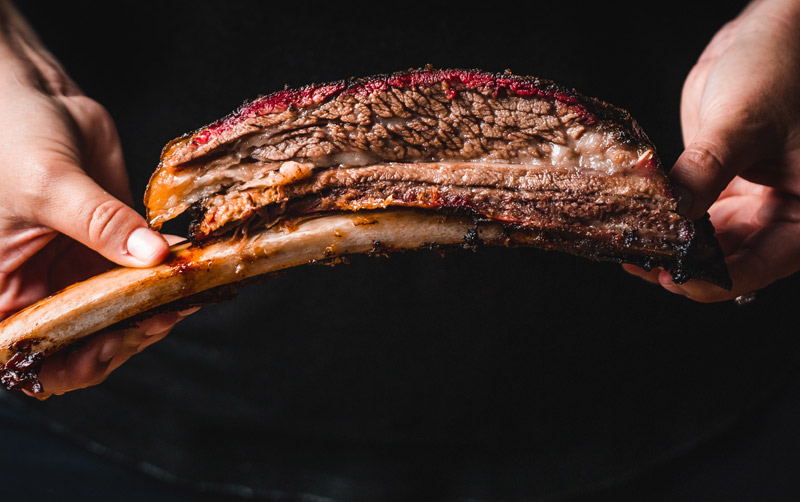Have you ever gone to a steakhouse only to be overwhelmed by the number of different types and cuts of steak available? You probably understand what cuts such as prime rib or filet mignon are but things like porterhouse and ribeye go right over your head.
What is a porterhouse vs. a ribeye steak and what are the differences in cut, cost, and cooking? We have the lowdown on which cut of steak is best for you and what’s going to satisfy you the most, whether you’re eating at a restaurant or cooking the steak at home.
Where does a ribeye steak come from?
As the name suggests, rib eye steak is cut from the rib section of beef. Specifically, it is taken from the upper rib cage of the cow, specifically from ribs six through twelve. Ribeye steak is quite tender and can be a bit fatty because this particular part of the cow’s anatomy doesn’t get a lot of exercise. Ribeye steak, along with a rib steak and prime rib, all come from the same cut of beef.
Where does the porterhouse steak come from?
While the ribeye steak comes from the upper rib cage of the cow, the porterhouse steak is taken from the lower rib portion, located closer to the rear end of loin. Movement in this area of the cow is low, just like the upper rib cage where ribeye comes from. A ribeye still tends to be fatty and tender because of the lack of exercise in this area.
Another difference between a ribeye and a porterhouse steak is that the porterhouse steak is made of two different cuts of beef, not one like the ribeye. A porterhouse consists of a strip steak on one side and a tenderloin filet on the other.
Difference in cut
As we mentioned, porterhouse and the ribeye steaks come from the same section of the cow, just slightly different locations. The ribeye is cut from the upper rib cage of the cow, the porterhouse from the lower rib portion. In regards to location, there’s not a vast difference between the two. The real differences are the amount of fat and the bone content, particularly since the porterhouse is part strip steak and part tenderloin.
Difference in Fat
Although both cuts come from the same area in the cow’s anatomy, the fact that one is taken from further down and one from higher up in the ribcage does affect the fat content. Interestingly, this is purely because of the subtle difference in exercise that a cow naturally gets in the different parts of its rib cage. So, not only does the porterhouse have a higher level of fat and a higher tenderness profile, it also has a different flavor and is often said to have a “meatier” taste.
Difference in Bone Content

The difference in bone content between these two steaks is the biggest differentiation between them. If you know what you’re looking for, you can tell these two cuts apart just by looking at them. The porterhouse is easily recognizable because it has one large, center bone in the shape of a “T” while a ribeye steak either contains no bone at all or a single bone towards the outside of the cut.
Difference in Cost
If you take a look at the United States Department of Agriculture’s National Retail Report for beef, the average price of these cuts varies by mere cents. The slight upsurge in price of the ribeye is mainly because it’s more popular but, when it comes down to it, you won’t notice much difference in cost between the two.
Difference in Cooking Methods
When it comes to cooking any steak, it’s really all about your preference for the taste, tenderness, and cooking method. Even though these cuts are very similar, there are slightly different recommended ways to cook them.
Cooking the Ribeye Steak
When cooking a ribeye steak, the recommended methods at to grill, broil, or pan-fry it, with pan-frying being the most ideal. This is because the ribeye is marbled in fat which can cause flare-ups. It’s best to cook this steak slowly and carefully.
Cooking the Porterhouse Steak
When cooking the porterhouse steak, grilling or broiling it are your best options. Using a hot grill is the most common way to cook a porterhouse because open flame grilling works well when you consider its fat content. Unlike the ribeye, pan-frying isn’t a good choice largely due to its shape and the fact that there’s a big bone right in the center. Another thing to keep in mind is that the porterhouse steak needs more time to cook because of its size and the large bone.
Which is better?
Now that we’ve nailed down the differences between these two types of steak, which one is considered to be better?
There’s no right answer to that question, it purely comes down to personal preference. If you prefer a tender, meatier tasting steak that is great for grilling, the porterhouse may be a better choice. If you like a slightly leaner steak that is great for pan-frying, go for a ribeye. Add some salt, black pepper, and a bit of seasoning and you have a delicious, flavorful main dish.
Honestly, we don’t think you can’t go wrong with either but we hope this guide will help you decide what to order on your next night on the town or when you’re getting ready to seriously impress your dinner guests. If you’re in the mood to go out to a restaurant, Outback Steakhouse is a long-standing favorite. View Outback Steakhouse’s menu and prices here.
Featured Photo by Paul Hermann on Unsplash

